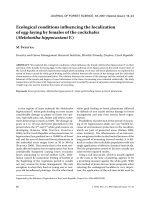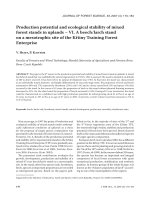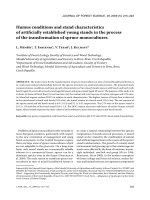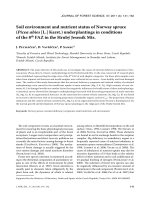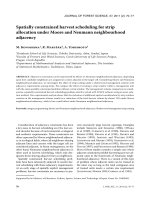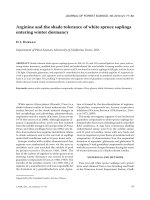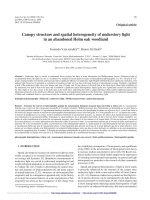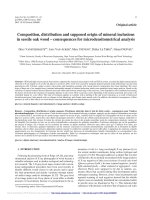Báo cáo lâm nghiệp: "Gibberellin A enhances flowering 4/7 of Picea glauca grafts in two consecutive years" pdf
Bạn đang xem bản rút gọn của tài liệu. Xem và tải ngay bản đầy đủ của tài liệu tại đây (167.4 KB, 3 trang )
Gibberellin
A
4/7
enhances
flowering
of
Picea
glauca
grafts
in
two
consecutive
years
R.A. Cecich
D.E.
Riemenschneider
1
USDA-Forest
Service,
Columbia,
MO
65211,
and
2
USDA-Forest Sf-rvice,
Rhinelander,
WI 54501
U.S.A.
Introduction
Trees
that
flower
abundantly
in
one
year
and
then
bear
sparsely
or
not
at
all
for
several
years
are
said
to
show
periodicity
of
flowering.
This
infrequent,
unpredictable
flowering
behavior
has
led
to
inefficient
seed
collecting
and
seed
orchard
opera-
tions.
Therefore,
treatments
to
alleviate
such
flowering
problems
in
conifers
have
been
the
subject
of
much
recent
experi-
mentation.
The
mixture
of
gibberellins
A4
and
A7
(GA4;7
)
can
increase
flowering
in
conifers
if
applied
at
the
correct
time,
duration
and
concentration
(Cecich,
1983;
Marquard
and
Hanover,
1984;
Pollard
and
Portlock,
1983).
Except
for
Marquard
and
Hanover
(1985),
all
experiments
with
GA
4í7
have
been
done
on
plants
never
previously
treated.
There
have
been
no
reports
of
GA
4i7
being
applied
to
the
same
tree
or
seedling,
or
even
the
same
branches,
in
two
consecutive
years.
Our
paper
reports
the
results
of
an
experiment
on
Picea
glauca
(Moench
(Voss))
grafts
in
which
GA
4,
’7
was
applied
to
the
same
branches
in
two
consecutive
years
in
an
attempt
to
overcome
periodic
flowering.
Materials
and
Methods
Readers
are
referred
to
Cecich
(1985)
for
details
of
the
experimental
design
and
treat-
ment
procedures.
The
first
GA
4,7
applications
were
made
in
1982.
In
1983,
GA
4/7
was
again
sprayed
on
the
same
trees
and
branches
on
the
same
dates.
Length
of
the
terminal
shoot
on
all
the
treated
and
control
lateral
branches
was
measured
in
August
1983
and
1984.
Ovulate
and
staminate
strobili
were
counted
in
early
May
1983
and
1984.
Flowering
data
were
trans-
formed
to
log,,
(x
+
1)
and
evaluated
by
a
com-
bined
analysis
of
variance
and
Duncan’s
new
multiple
range
test.
Simple
correlation
coeffi-
cients
were
computed
for
the
1983
and
1984
flowering
and
branch
length
data.
Results
The
1983
flowering
results
for
the
5
early-
flushing
(EF)
and
5
late-flushing
(LF)
white
spruce
clones
have
been
published
else-
where
(Cecich
1985),
but
treatment
means
are
summarized
in
Table
I for
convenience
of
comparison
with
the
1984
mean
results.
In
both
years,
the
GA
4!T
treated
branches
on
ramets
of
the
EF
and
LF
clones
produced
significantly
more
ovulate
and
staminate
strobili
than
branches
on
their
paired
control
ramets.
In
1984,
the
LF
clones
again
produced
signi-
ficantly
more
ovulate
strobili
than
the
EF
clones.
This
was
reversed
for
staminate
strobili;
that
is,
the
EF
clones
produced
more
than
the
LF
clones.
Spraying
with
GA
4/7
in
1982
had
no
effect
on
lateral
branch
length
of
either
the
EF
or
LF
clones
in
1983.
However,
in
1984
the
GA
4/7
-treated
branches
were
about
25%
shorter
than
the
control
branches.
The
EF
clones
had
a
mean
length
of
185
mm
for
the
controls
and
141
mm
for
the
GA4»
-tr
P
atca
branches.
The
LF
control
!a!nets
had
an
average
branch
length
of
217
mm,
while
the
treat-
ed
branches
were
163
mm
long.
Treated
branches
on
EF
and
LF
clones
responded
with
significant
increases
in
flowering
in
1983
and
1984
(Table
I).
Interactions
were
due
to
a
change
in
magnitude
of
response,
rather
than
to
a
change
in
rank
of
the
treatment
combina-
tions.
Clone
x
treatment
interactions
for
staminate
strobilus
production
tP
<-
0.01)
were
apparently
more
complex
than
for
ovulate
strobilus
production
(NS)
in
that
they
were
not
related
to
flushing
type
but
to
specific
clones.
Ovulate
and
staminate
strobilus
produc-
tions
in
1983
and
1984
were
significantly
correlated
(r
=
0.760
*
).
Branch
length
was
negatively
correlated
with
production
of
ovulate
strobili
(r = -0.758
*)
and
staminate
strobili
(r = -0.931
**).
Discussion
This
report
is
the
first
to
describe
the
suc-
cessful
stimulation
of
male
and
female
flowering
in
a
conifer
by
consecutive
annual
treatments
with
GA4!7.
The
1984
results
substantiated
the
1983
observa-
tions
that
the
treated
LF
ramets
produced
significantly
more
ovulate
strobili
than
the
treated
EF
ramets.
In
1983,
there
was
no
difference
in
s!laminate
strobilus
produc-
tion
between
EEF
and
LF
clones
but,
in
1984,
the
EF
clones
produced
significantly
more
staminate
strobili
than
the
LF
clones.
In
unpublished
experiments,
flowering
was
promoted
by
GA4n
in
both
flushing
types;
but
the
response
was
closely
related
to
a
common
date
(June
20),
indicating
a
pos-
sible
environmental
control,
or
a
larger
than
expected
’window’
for
treatment
application.
Needles
of
the
elongating
branch
tips
in
the
EF
families
began
to
harden
on
June
13,
1
wk
before
the
opti-
mum
treatment
date.
Needle
harden-
ing
was
noted
1
wk
later
in
the
LF
families.
Hardening
of
the
needles
could
potentially
be
used
to
determine
when
to
apply
GA
4
n.
Branch
length
reduction
by
a
heavy
flowering/cone
crop
could
affect
the
use
of
a
certain
percentage
of
the
previous
year’s
growth
as
an
index
of
when
to
apply
GA4n
.
The
final
length
of
the
treated
branches
in
1984
was
75%
of
the
control
length
and
70&dquo;/
°
of
the
previous
year’s
s
treated
branch
length.
If
one
had
used
the
proposed
index
of
90%
(Owens
and
Mol-
der,
1977)
or
75%
(Marquard
and
Hano-
ver,
1984)
for
GA
4f7
application,
the
’win-
dow’
would
have
been
missed.
Under
these
circumstances,
calendar
dates,
needle
hardening
and/or
bud
morphology
may
be
preferred
for
scheduling
treat-
ments.
These
results
suggest
that
periodic
flow-
ering
in
white
spruce
can
be
overcome
with
judicious
spray
application
of
GA4f7’
Furthermore,
the
lack
of
significant
inter-
actions
for
clone
x
treatment
and
clone
x
year
for
ovulate
strobili
suggests
that
GA
4f7
can
be
used
to
overcome
clonal
variation
in
female
flowering.
However,
unequal
representation
of
clones
as
pollen
parents,
as
exemplified
by
the
strong
clone
x
treatment
interaction,
might
be
a
possible
concern
for
an
orchard
manager.
Conclusions
Although
the
present
data
are
encour-
aging
that
year-to-year
regularity
in
seed
production
can
be
achieved,
additional
experiments
are
required
to
determine
the
number
of
years
in
which
a
significant
re-
sponse
can
be
elicited.
References
Cecich
R.A.
(1983)
Flowering
in
a
jack
pine
seedling
seed
orchard
increased
by
spraying
with
gibberellin
A
4/7
-
Can.
J.
For.
Res.
13, 1056-
1062
Cecich
R.A.
(1985)
White
spruce
(Picea
glau-
ca)
flowering
in
response
to
spray
application
of
gibberellin
A4,7-
Can.
J.
For.
Res.
15,
170-174
Marquard
R.D.
&
Hanover J.W.
(1984)
Relation-
ship
between
gibberellin
A
4n
concentration,
time
of
treatment,
and
crown
position
on
flow-
ering
of
Picea
glauca.
Can.
J.
For.
Res.
14,
547-553
Marquard
R.D.
&
Hanover
J.W.
(1985)
Floral
response
of
Picea
glauca
to
gibberellin
A
4/7’
naphthalene
acetic
acid,
root
pruning,
and
bien-
nial
treatment.
Can.
J.
For.
Res.
15,
743-746
Owens
J.N.
&
Molder
M.
(1977)
Bud
develop-
ment
in
Picea
glauca.
11.
Cone
differentiation
and
early
development.
Can.
J.
Bot.
55,
2746-
2760
Pollard
D.F.W.
&
Portlock
F.T.
(1983)
Timing
and
duration
effects
of
gibberellin
and
fertilizer
treatment
on
strobilus
production
in
young
western
hemlock.
Can.
For.
Serv.
Res.
Notes
3,
3-5
